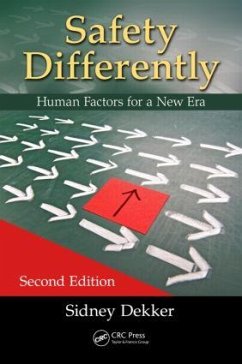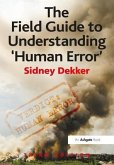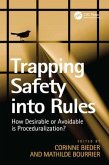The second edition of a bestseller, Safety Differently: Human Factors for a New Era is a complete update of Ten Questions About Human Error: A New View of Human Factors and System Safety. Today, the unrelenting pace of technology change and growth of complexity calls for a different kind of safety thinking. Automation and new technologies have resulted in new roles, decisions, and vulnerabilities whilst practitioners are also faced with new levels of complexity, adaptation, and constraints. It is becoming increasingly apparent that conventional approaches to safety and human factors are not equipped to cope with these challenges and that a new era in safety is necessary.
In addition to new material covering changes in the field during the past decade, the book takes a new approach to discussing safety. The previous edition looked critically at the answers human factors would typically provide and compared/contrasted them with current research and insights at that time. The edition explains how to turn safety from a bureaucratic accountability back into an ethical responsibility for those who do our dangerous work, and how to embrace the human factor not as a problem to control, but as a solution to harness.
See What's in the New Edition:
New approach reflects changes in the fieldUpdated coverage of system safety and technology changesLatest human factors/ergonomics research applicable to safety
Organizations, companies, and industries are faced with new demands and pressures resulting from the dynamics and nature of the modern marketplace and from the development and introduction of new technologies. This new era calls for a different kind of safety thinking, a thinking that sees people as the source of diversity, insight, creativity, and wisdom about safety, not as the source of risk that undermines an otherwise safe system. It calls for a kind of thinking that is quicker to trust people and mistrust bureaucracy, and that is more committed to actually preventing harm than to looking good. This book takes a forward-looking and assertively progressive view that prepares you to resolve current safety issues in any field.
In addition to new material covering changes in the field during the past decade, the book takes a new approach to discussing safety. The previous edition looked critically at the answers human factors would typically provide and compared/contrasted them with current research and insights at that time. The edition explains how to turn safety from a bureaucratic accountability back into an ethical responsibility for those who do our dangerous work, and how to embrace the human factor not as a problem to control, but as a solution to harness.
See What's in the New Edition:
New approach reflects changes in the fieldUpdated coverage of system safety and technology changesLatest human factors/ergonomics research applicable to safety
Organizations, companies, and industries are faced with new demands and pressures resulting from the dynamics and nature of the modern marketplace and from the development and introduction of new technologies. This new era calls for a different kind of safety thinking, a thinking that sees people as the source of diversity, insight, creativity, and wisdom about safety, not as the source of risk that undermines an otherwise safe system. It calls for a kind of thinking that is quicker to trust people and mistrust bureaucracy, and that is more committed to actually preventing harm than to looking good. This book takes a forward-looking and assertively progressive view that prepares you to resolve current safety issues in any field.
"Sidney Dekker has established himself as the foremost thought leader on accident causation and human error. He points out that we continue to follow linear thinking about accidents and look at the person and the choices they make as the problem. Thus, we develop ineffective interventions intended to "fix" workers through motivation, training, and discipline. ... Through this book, Dekker calls on safety professionals to stop and think critically about the path forward. He calls for us to engage in a conversation about how we look at human error. The time has come for a new era that better understands human error in the context of work, and the overriding importance of improved work design; design that is tolerant of human error and allows humans who make mistakes or become confused to fail safely."
-Richard A. Pollock, President, CLMI Safety Training and American Society of Safety Engineers
"As expected Sidney Dekker compels the next level of productive thinking. It is a challenge to think broader and react less. He tells the how and why of "old view" sociotechnical embeddedness and reveals why its usefulness has diminished ... Sidney writes in such a way that the whole book becomes an example of applied "local rationality". ... He provides strong motivation to embrace the hard work of developing a holistic perspective mindset and break free of dualistic deconstructionist approaches and language."
-Paul Nelson, MSc, Nelson HF Safety Consulting, LLC
"... an exciting exposé of the current system of safety management and how it came to be. ... Professor Dekker asks us to look beyond the purely technical, and to reflect on our feelings about safety processes. Then he presents a clear story about why these feelings might be preventing us from producing the very changes that are needed to move to the next level of safe operations. He probes us to explore what fundamentally makes safety such an elusive challenge and what makes it different from other sciences. ... provides the framework that will move us to a new level of practice and thinking that could be to this generation of safety practitioners, what technical "fixes" were to the safety managers of the 1970s."
-Ivan Pupulidy, US Forest Service
"... After reading Sidney's work you feel inspired to change the 'way we've always done business' and to look at safety management in a very different way. This book is very timely against the strengthening tide of criminalization of failure - it counters by providing a sound perspective on system complexity and foreseeability - it recognizes that ethics have taken a back seat to safety over the bureaucratic control it so often has become. This book is indeed a 'stop and think' - its content provides concepts for critical thinking and invites, challenges and persuades all those who care about safety to think and act differently."
-Jenny Colman - Human Factor Specialist, Fatal and Serious Injury Investigation Dept. WorkSafeBC
"... Sidney has so thoroughly exposed the philosophical derailment caused by a modernist-only agenda that to continue to go down that track would be logically pathetic. ... turns most of the popular literature on Human Factors and Crew Resource Management upside down and sideways, but doesn't leave the reader perplexed and lost. He cleverly explains why all future thinking about human error must shift from a discourse on the complicated to a discourse on the complex. In coming years, Sidney's views will have created the answer to the question "What do we do after modernism?" Just as Einstein displaced some of Newton's thoughts about the universe and the physics of gravity and light, Sidney Dekker has displaced some of Newton's and Descartes' thoughts about how we are to analyze the known world. This book is a must read for every student in collegiate aviation programs around the world."
-Todd P. Hubbard, Ed.D., University of Oklahoma
"I believe this book will become a foundational reference for all students and practitioners and promoters of system safety initiatives and interventions in complex social organizations and work situations. The comprehensive nature of the approach adopted in this book is based on both a strong historical understanding of the topic as well as an impressive appreciation of the important philosophical underpinnings of system safety efforts. Dekker has laid a strong historical and philosophical foundation on which he builds operationally relevant guidance about sense-making in complex adaptive systems."
-Dr. Robert Robson, Healthcare System Safety and Accountability
"... Here in one volume is an authoritative account that is rich in Prof Dekker's unique experience of safety, science and his experience of safety in vastly different domains. The result is challenging and surprising, And at last there is one book that brings the various strands of these influences into what we call today safety science."
-Anthony Smoker, Manager Operational Safety Strategy NERL/NATS
"... easily accessible for practitioners and really inspiring and provocative for scientists. Dekker's reasoning is amazingly easy to follow, especially when he is challenging various folk models, which are often strongly incorporated in our thinking. The history of safety science and of role of human in systems is pictured masterfully. But the main strength is that it offers smooth intellectual ride from "stone-age" safety thinking to resilience engineering. Of course, smooth and comfortable for readers, for the world of safety is a struggle. But at least there is a inspiration."
-Hubert K. Adamczyk, Polish Air Traffic Controllers Union (Executive Vice President); Human Factors Specialist and Safety Investigator
"... easy to read and to understand. ... written in such a way that also interested people from outside the safety field can understand ... the first book that I 'm aware of, that challenges the dominating view/beliefs on the role of the human factor (based on modernist assumptions) within the safety domain. ... Brilliantly written ... a very interesting view on the way modern safety is shaped by the past and how it could be of influence on the future. ... has the potential to unlock a more human approach of safety."
-Ruud Plomp, ManageNet/Thin Green Line, The Netherlands
-Richard A. Pollock, President, CLMI Safety Training and American Society of Safety Engineers
"As expected Sidney Dekker compels the next level of productive thinking. It is a challenge to think broader and react less. He tells the how and why of "old view" sociotechnical embeddedness and reveals why its usefulness has diminished ... Sidney writes in such a way that the whole book becomes an example of applied "local rationality". ... He provides strong motivation to embrace the hard work of developing a holistic perspective mindset and break free of dualistic deconstructionist approaches and language."
-Paul Nelson, MSc, Nelson HF Safety Consulting, LLC
"... an exciting exposé of the current system of safety management and how it came to be. ... Professor Dekker asks us to look beyond the purely technical, and to reflect on our feelings about safety processes. Then he presents a clear story about why these feelings might be preventing us from producing the very changes that are needed to move to the next level of safe operations. He probes us to explore what fundamentally makes safety such an elusive challenge and what makes it different from other sciences. ... provides the framework that will move us to a new level of practice and thinking that could be to this generation of safety practitioners, what technical "fixes" were to the safety managers of the 1970s."
-Ivan Pupulidy, US Forest Service
"... After reading Sidney's work you feel inspired to change the 'way we've always done business' and to look at safety management in a very different way. This book is very timely against the strengthening tide of criminalization of failure - it counters by providing a sound perspective on system complexity and foreseeability - it recognizes that ethics have taken a back seat to safety over the bureaucratic control it so often has become. This book is indeed a 'stop and think' - its content provides concepts for critical thinking and invites, challenges and persuades all those who care about safety to think and act differently."
-Jenny Colman - Human Factor Specialist, Fatal and Serious Injury Investigation Dept. WorkSafeBC
"... Sidney has so thoroughly exposed the philosophical derailment caused by a modernist-only agenda that to continue to go down that track would be logically pathetic. ... turns most of the popular literature on Human Factors and Crew Resource Management upside down and sideways, but doesn't leave the reader perplexed and lost. He cleverly explains why all future thinking about human error must shift from a discourse on the complicated to a discourse on the complex. In coming years, Sidney's views will have created the answer to the question "What do we do after modernism?" Just as Einstein displaced some of Newton's thoughts about the universe and the physics of gravity and light, Sidney Dekker has displaced some of Newton's and Descartes' thoughts about how we are to analyze the known world. This book is a must read for every student in collegiate aviation programs around the world."
-Todd P. Hubbard, Ed.D., University of Oklahoma
"I believe this book will become a foundational reference for all students and practitioners and promoters of system safety initiatives and interventions in complex social organizations and work situations. The comprehensive nature of the approach adopted in this book is based on both a strong historical understanding of the topic as well as an impressive appreciation of the important philosophical underpinnings of system safety efforts. Dekker has laid a strong historical and philosophical foundation on which he builds operationally relevant guidance about sense-making in complex adaptive systems."
-Dr. Robert Robson, Healthcare System Safety and Accountability
"... Here in one volume is an authoritative account that is rich in Prof Dekker's unique experience of safety, science and his experience of safety in vastly different domains. The result is challenging and surprising, And at last there is one book that brings the various strands of these influences into what we call today safety science."
-Anthony Smoker, Manager Operational Safety Strategy NERL/NATS
"... easily accessible for practitioners and really inspiring and provocative for scientists. Dekker's reasoning is amazingly easy to follow, especially when he is challenging various folk models, which are often strongly incorporated in our thinking. The history of safety science and of role of human in systems is pictured masterfully. But the main strength is that it offers smooth intellectual ride from "stone-age" safety thinking to resilience engineering. Of course, smooth and comfortable for readers, for the world of safety is a struggle. But at least there is a inspiration."
-Hubert K. Adamczyk, Polish Air Traffic Controllers Union (Executive Vice President); Human Factors Specialist and Safety Investigator
"... easy to read and to understand. ... written in such a way that also interested people from outside the safety field can understand ... the first book that I 'm aware of, that challenges the dominating view/beliefs on the role of the human factor (based on modernist assumptions) within the safety domain. ... Brilliantly written ... a very interesting view on the way modern safety is shaped by the past and how it could be of influence on the future. ... has the potential to unlock a more human approach of safety."
-Ruud Plomp, ManageNet/Thin Green Line, The Netherlands








